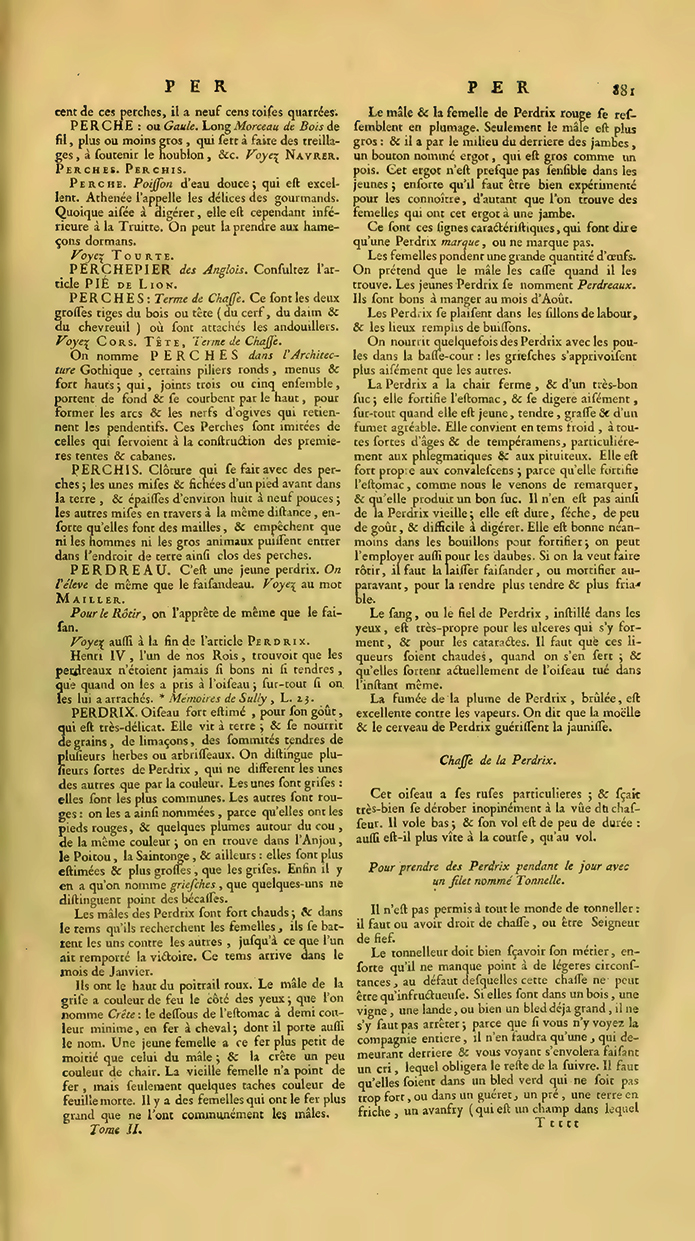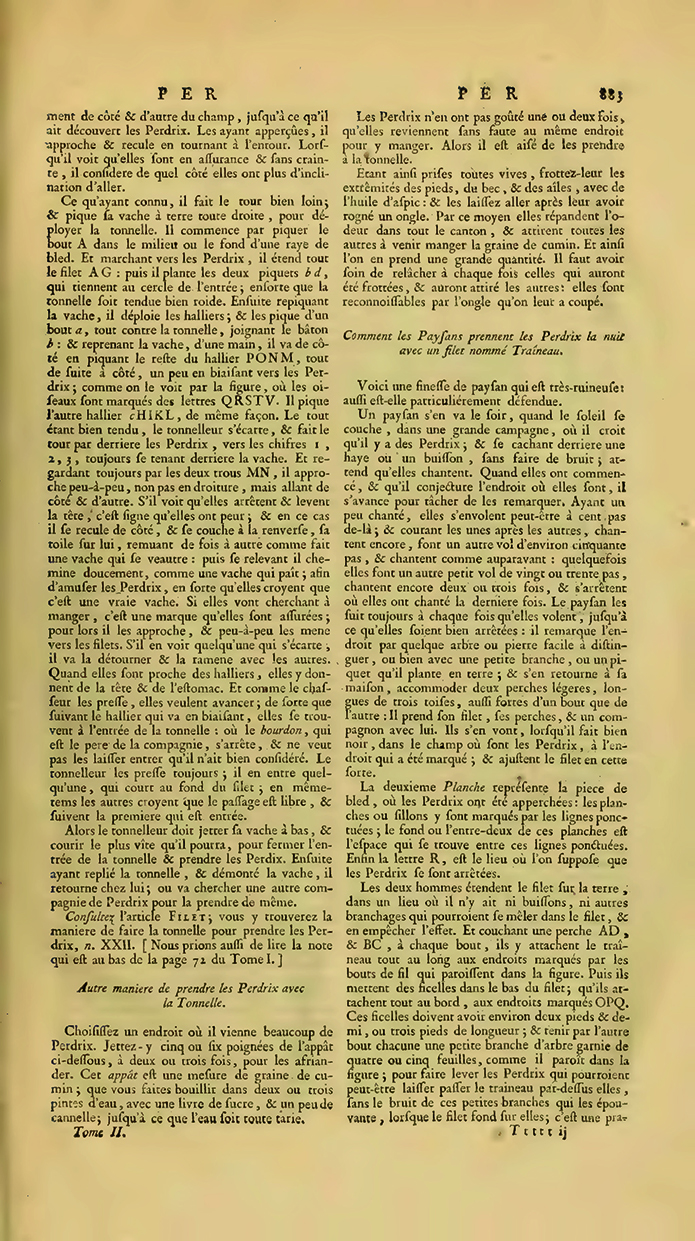Not least among the many remaining undecrypted peculiarities of Deleuze and Guattari’s A Thousand Plateaus are the images preceding each of the plateaus. While the sources of some of them and their relation to the content are clear enough, others are rather more oblique and take some serious detective work to track down.
The image for Apparatus of Capture, it turns out, is more literal than may appear at first sight, but also more bizarre than you might expect. It is in fact a diagram from an eighteenth-century household and agricultural manual, illustrating the construction of an artificial cow for the purpose of catching birds.
First published in 1709, Noel Chomel’s Dictionnaire Œconomique, contenant divers moyens d’augmenter son bien, et de conserver sa santé went through many editions, all of which are full of fascinating diagrams. The figure in question, which forms part of a subsection of the entry Perdrix (Partridge), seems to appear first in the 1740 edition (Lyon: Bruyset), and also features in the 1767 edition printed in Paris.1
What the figure shows is a ‘tunnel’ (or ‘arbour’) method for catching partridges,2 which involves the fabrication of an artificial cow with peepholes through which the farmer watches the birds while stalking them and attempting to maneouvre them into the net tunnel. One can appreciate why the authors would have found it an amusing example of an apparatus of capture—it is certainly a strangely laborious way to catch a partridge (Aha!). Translation of the full entry is below.3
I’m now looking into some of the other less obvious plateau images and will report back…
Fabrication of an Artificial Cow for Tunnelling
The cow is shown in the figure on the following page. It should be made from a piece of cloth XYGH, four feet square, the colour of a cow. At the four corners XRHG from the middle of the top, at the places marked with the letters EF, small pieces of the same cloth, two inches square in size, should be sewn to hold and stop the ends of the sticks OP, which cross over, and the top of the fork. The two sticks must be long enough to hold the cloth well stretched out and taut when they cross over, as shown in the figure. The fork must be at least four and a half feet long with the tip 1 cut into a point, which passes through a small piece of cloth K sewn into the middle of the base of the large cloth. This fork, and the two sticks OP, are tied together with a rope which is attached to the middle of the canvas at the letter L. On the side marked Y is sewn a piece of cloth QY made in the shape of a cow’s head, of the same colour as the rest of the cloth, with an eye Q and two horns made from some pieces of hat, and on the other side X is a tail made from oakum or something other suitable material.
I advise placing a stick at the top, from X to Y, to keep the head QY and the tail X in place, and to make sure the other sticks and the entire body of the cow hold better. The tail should not be attached to the very edge of the canvas, there must be a little space between, so that when walking the tail can swing. Make two holes MN in the middle of the canvas, a foot from the top, to look through so as to keep in view the partridges or other birds you wish to approach.
Farmers and others who are nervous in hunting do not use dogs, but go out into the country at daybreak to listen for the partridges singing, for there are always some.
Once the person who is to make the tunnel is sure of the place where they last sang, he puts on the cow, and as soo as he can see clearly enough to spot them, he gets ready, as you will see in the following figure, which I mean to represent a whole field of wheat, and the spaces between the dotted lines marked with the numbers 123, the bases of the strips or the gaps between the wheat, through which the partridges run unhindered. The Driver, with the tunnel and stakes on his shoulder, takes the cow with both hands by the middle L, where all the sticks are tied together, and, looking through the two holes MN, moves slowly from one side of the field to the other until he has found the Partridges, and, having spotted them, approaches and backs away, circling them, when he sees that they are confident and unafraid; he works out which way they are more inclined to go.
When he knows this, he moves far away, and sticks his cow straight down into the ground in order to unfold the tunnel, starting with the tail, sticking the end A in the middle or the bottom of a strip of wheat; walking towards the partridges, he spreads out the whole net AF, then plants the two stakes b and d, which hold the circular entranceway, so that the tunnel is becomes taut, and then, putting the cow back on, he unfolds the hallier-nets and stakes them with from one end a, right up against the tunnel joining stake b, and, taking the cow in one hand, he moves sideways staking out the links of the hallier-net PONM, immediately sideways, slanting a little toward the partridges, as can be seen in the figure, where the birds are marked with the letters QRSTV. In the same way, he stakes out the other hallier-net, CHIKL. When the whole is finished, the tunneller moves aside and goes round behind the partridges, toward numbers 123, as can be seen in the figure, which represents the cow, behind which he must place himself. Still looking through the two holes MN, he approaches them little by little, not straight on, but moving from side to side. If he sees them stop and raise their heads, this is a sign that they are afraid, and in that case he must pull back to one side and lie down on his back with the canvas over him, sometimes moving as a cow or horse does when it is calving; then, getting up again, he walks slowly from side to side like a cow grazing; this comforts them, since they think it is a real cow. If they go looking for food, it is a sign that they are secure, so he approaches them and gradually leads them into the nets. If he sees one of them wandering off, he will turn it round and bring it back with the others, as with a flock of sheep. When they come close to the hallier-nets, they bump their heads and breasts against them, and as the farmer is pressing them, they want to move on; so that, following the hallier-net, which brings them inward, as I have said, they find themselves at the entrance to the tunnel, where the bourdon,4 who is the head of the company, stops, not wanting to let them in until he has considered it carefully; the tunneller keeps on pressing them, until one enters and runs to the end of the net, then the others will believe that the way is clear and will follow the first to enter.
At this point the tunneller must throw down his cow and run as fast as he can to close the tunnel entrance and catch the partridges. Then, having folded up the tunnel and dismantled the cow, he returns home, or goes to attempt a further capture.
See the article on NETS for instructions on how to make the tunnel to catch partridges.
- The full title of the book, as it appears in the 1725 English translation, is as follows: Dictionaire Oeconomique: or, The Family Dictionary. Containing the most experienced methods of improving Estates and of preserving Health… The most advantageous ways of breeding, feeding and ordering all sorts of Domestick Animals … The different kinds of Nets, Snares and Engines for taking all sort of fish, birds, and other game. Great variety of rules, directions, and new discoveries, relating to Gardening, Husbandry, Soils and Manures of all sorts … the knowledge of foreign drugs, dies, domestick and exotic plants and herbs, with their specific qualities and medicinal virtues. The best and cheapest ways of providing and improving all manner of Meats and Drinks… Means of making the most advantage of the manufactures of Soap, Starch, Spinning, Cotton, Thread, &c. The methods to take or destroy Vermin and other animals, injurious to gardening, husbandry, and all rural oeconomy… An account of the several Weights, Measures, &c. of Metals and Minerals, with their preparations and uses. All sorts of Rural Sports and Exercises … The whole illustrated throughout with very great variety of Figures, for the readier understanding and practising of things to which they belong.)
- Among the other methods detailed in Chomel’s book is the fascinating ‘mirror’ method for catching larks…
- Of course, someone got there before me. See this post from 2009.
- Despite the fact that partridges are known for being birds that tend to pair for life, it seems that in mediaeval France they had a reputation for licentious behaviour, on account of the fact that paired birds often attracted another cock who, if he failed to win over the hen, would become attached and hang around with them, making a threesome. This extra member of the family was known as a bourdon—literally ‘bee’—because it buzzes around the couple like a bee around a flower. (Information from Pratique.)—trans.




